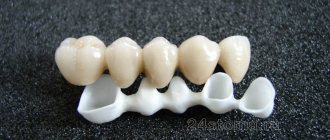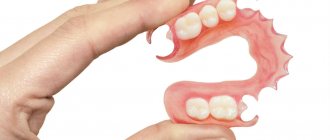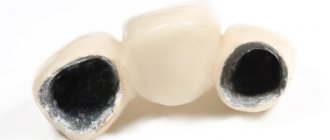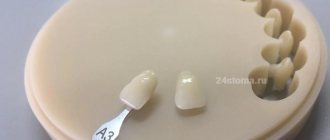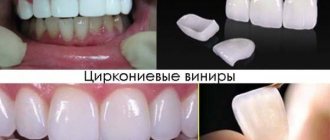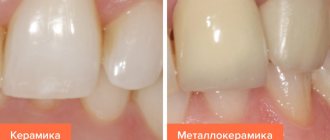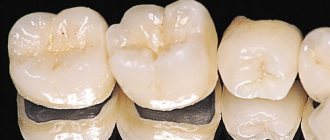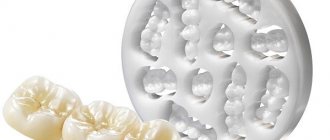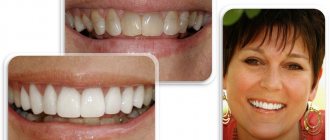Metal-ceramic crown
This is a prosthetic structure consisting of a metal frame and a ceramic coating applied to it. It is made from nickel-chromium or cobalt-chromium alloy. The crowns are very durable, and thanks to the ceramic veneer, it is possible to imitate the natural color and shine of teeth.
Advantages:
- affordable price;
- aesthetically attractive appearance;
- ability to withstand heavy chewing loads;
- resistance to deformation and displacement;
- does not cause irritation of the mucous membrane;
- does not fade over time;
- is settling in well.
Flaws:
- before installing the prosthesis, it is necessary to grind the teeth (up to 2 mm around the entire circumference);
- Depulping is mandatory;
- there is a risk of exposing the crown frame;
- translucency of the base is observed when the ceramic layer is naturally erased.
The procedure for making crown structures for teeth made of metal-ceramics
- Before proceeding with crown modeling, the client is prescribed a series of laboratory examinations. To install a prosthesis, the patient's oral cavity must be completely healthy. Found open cavities are filled and professional cleaning is prescribed.
- Based on the results of the preparatory period, you can begin selecting the product. Some are known for their durability, while others come with more than a year's warranty.
- The production of the prosthesis is carried out in laboratory conditions in stages.
- To obtain a high-quality impression, the doctor carries out a procedure for preparing the supporting part of the chewing element. After which you can make a two-layer print. Then, permanent fixations or bridges are installed in place of the prepared teeth. The dentist must determine the center of closure of the dental system.
- The one-piece metal crown frame is precisely adjusted to size, and the ceramic veneer is selected to match the color of the patient’s teeth.
Zirconium crown
This is the latest development in the field of dental prosthetics. The crown contains no metal elements; the frame is made of zirconium dioxide, and the outer covering is made of porcelain enamel.
Advantages:
- hypoallergenic;
- low likelihood of rejection and negative reactions;
- crowns are perceived by the body as bone tissue, since their physical and chemical properties are very similar;
- teeth need to be ground down only 0.4 mm;
- minimal risk of inflammatory processes;
- high strength (zirconium crowns are 30 times stronger than metal-ceramics);
- resistance to coloring with food dyes;
- natural appearance;
- painless and fairly simple installation.
Flaws:
- high price;
- complex and labor-intensive manufacturing technology.
What patients who decide to have a metal-ceramic bridge need to know
First and foremost, the installation of a metal-ceramic crown can be done using different methods, and the options for making prostheses may differ, but the main thing in the prosthetics process, on which the reliability, quality, service life and aesthetics of the products will directly depend, is the stage of preparing the teeth. In addition, the procedure of grinding and taking an impression will play an important role here.
1. Endodontic preparation of teeth.
What is meant by these words? This is nothing more than filling root canals. Despite the professionalism of many doctors, it is possible to correctly fill the root canal only in 40-45% of cases. Poor filling causes an inflammatory process and, as a result, it will be necessary to remove the metal-ceramic bridge, re-treat the teeth and begin a new stage of prosthetics. In order to avoid getting into such a situation, it is important after filling the root canals:
- take a control photo;
- get advice from a specialist who, after analyzing the image, will confirm that the teeth preparation procedure was successful.
Attention! We offer 100% high-quality root canal treatment using innovative methods using professional imported equipment and materials. Contacting our specialists will allow you to avoid the occurrence of granulomas and cysts under the crowns, and therefore get adequate preparation of your teeth for the prosthetic process.
2. Preparation (grinding) of teeth for crowns.
A special feature of the process of grinding teeth for crowns is the presence of a special “ledge”. Thanks to this method:
- bacteria and food debris do not accumulate under the crown, creating unpleasant sensations;
- the service life of products is significantly extended;
- The crown is a beautiful extension of the tooth root.
3. Taking impressions.
Even if all of the above points are performed at the highest level, without a competent and professional approach to taking impressions, the procedure for installing crowns will not be of high quality. A-silicone is considered an excellent impression compound, and a polyester composition is an ideal option. The use of such impression materials allows you to accurately replicate the features of the oral cavity.
It is important to know! The slightest dishonesty of the dentist, the use of low-quality materials at the stage of grinding teeth or when taking impressions will lead to the fact that the manufactured product will not fit well to the neck of the tooth. The consequence is the leakage of saliva, the entry of bacteria, and rotting of the teeth under the crown itself.
How does the crown installation process work?
Metal-ceramic dental prosthetics is a long process that takes several stages. First, the patient will have to cure caries and other diseases of the oral cavity, then the enamel will be ground down and the nerve will be removed (if necessary). After this, an impression is made of the prepared tooth, which will be sent to a dental laboratory to make a crown (this can take up to 2 weeks). Then the fitting and adjustment of the structure is carried out.
The process of installing zirconium crowns is as follows:
- The patient undergoes an initial examination of the oral cavity by an orthodontist; if inflammatory processes are detected, further treatment will be required.
- The doctor grinds the tooth for the future crown and makes silicone impressions.
- The impressions are sent to the dental laboratory. The crown is modeled on a computer and then manufactured using high-precision milling equipment. The finished prosthesis is fired and painted.
- The crown is installed in the oral cavity using cement mortar. The procedure takes from 30 minutes to 3 hours.
Grinding of teeth
In prosthetics, there are several methods of preparation for metal ceramics. Tooth grinding can be done in two ways, described below.
Metal-ceramics with ledge
The orthopedist, when grinding the dental tissues, forms a circular ledge along the lower edge, which avoids contact of the metal frame with the gums, and, as a result, minimizes the risk of swelling, irritation, bleeding and allergies. With such turning, it is possible to use metal-ceramics with shoulder mass to improve aesthetics. The shoulder mass is applied in the area of the ledge under the metal ceramics and serves to hide the strip of gray metal that shows through the enamel at the base of the crown. Installation of metal-ceramic with a shoulder and shoulder mass usually costs more, but these costs are completely justified and allow you to avoid many problems with dentures. In addition, grinding for metal ceramics with a shoulder extends the service life of the crown by several years.
Turning without shoulder
This is an outdated method that was previously used to install stamped steel prostheses or metal-plastic crowns. However, some doctors still use it for preparation under metal ceramics, which leads to negative consequences. Preparing a tooth without a shoulder does not provide enough space for a crown, so the gum contours are compromised. The outer perimeter of the artificial crown is larger than that of a natural tooth. As a result, a space is formed between the metal ceramics and the gum where plaque accumulates, the exposed edge of the denture looks unaesthetic, and the structure itself constantly injures the surrounding soft tissues. In this regard, if a doctor grinds teeth for metal-ceramics without a ledge, the crown will need to be replaced after 5-6 years.
Quality indicators of materials
| Indicators | Zirconium dioxide | Metal ceramics |
| Strength | Very high | High |
| Lifetime | 20 years or more | Up to 10 years |
| Impact on the body | Low risk of allergies | There is a possibility of oxidation and allergic reactions |
| Color preservation | Color does not change | Color does not change |
| Thickness | 0.3-0.4 mm | 1.5-2 mm |
| Price | From 15,000 rub. | From 7000 rub. |
Good to know. Many patients are not satisfied with the high cost of zirconium crowns, so they choose metal-ceramics as a cheaper option.
Pros and cons of metal-ceramic dental prosthetics
Has the following advantages:
- aesthetics - the design is absolutely no different in appearance from living teeth, harmonizing with them in shape and color (an extensive palette of shades of ceramic coating);
- biological compatibility – indifference to oral tissues, practically does not cause allergies (there is always a percentage of side effects, depending on individual sensitivity);
- functionality – teeth made of metal-ceramics function on a par with natural ones and do not create differences or discomfort;
- durability - durable, withstands chewing loads well, distributes them evenly, which minimizes the risk of chips, cracks, and deformation. Service life is about 10 years or more;
- hygiene – not susceptible to the influence of bacteria and microorganisms;
- color fastness - not colored by any food coloring, which eliminates restrictions on food and drinks;
- tooth protection – fits tightly to the surface, preventing further destruction.
Flaws:
- depulping and turning - installation requires removal of dental nerves and partial removal of hard tissues;
- It is possible for the contacting natural teeth to wear down because they are softer.
The main places for installing such dentures are the lateral areas, which bear the chewing load. On the front teeth, structures based on zirconium dioxide are used, which does not shine through the ceramics. Crowns are placed on a partially destroyed tooth. If only the root remains, then a metal-ceramic is installed on the pin, and if one or more teeth are completely missing, a bridge is installed.
Is it possible to put metal ceramics and zirconium on implants?
Crowns made from these materials can be placed on implants. If we are talking about prosthetics for the front teeth, it is better to choose a ceramic prosthesis, the abutment of which is made of zirconium dioxide. When restoring teeth in the lateral jaw, metal ceramics and zirconium can be used.
It is important to know. If you decide to install metal-ceramic dentures, be prepared for the fact that your teeth will be severely ground and depulped.
To install crowns made of metal ceramics or zirconium dioxide, you can contact the Saint-Dent Clinic in Moscow. It employs qualified specialists with extensive experience in providing dental services. You can find out about the prices for installing dentures in this PRICES section. The clique's contacts are located here CONTACTS.
Rules for caring for a metal-ceramic tooth crown
- Fixed dentures (crowns) do not require individual care; standard hygiene procedures are sufficient. It is mandatory to brush your teeth in the morning and evening, just before bed. It is advisable to use special rinses to clean the mouth.
- The toothbrush should be soft and not injure the gums. It is recommended to use dental floss to remove food debris and plaque.
- For preventive purposes, it is recommended to remove tartar once every six months and grind high points on the dentures in a clinical setting.
- At the first sign of pain, you should visit a doctor. The cause of pain may be the onset of a new pathology or poor-quality installation of a metal-ceramic prosthesis.
- Clients should be aware that when undergoing an MRI, if necessary, the prosthesis may appear as a defect in the image, so they should inform the doctor about the presence of a crown before the procedure.
Possible problems and complications
| Metal-ceramic crowns | Zirconium crowns |
| Inconsistency between the color scheme of dentures and the natural dentition. Incorrectly selected prosthesis size. Poor fit of the crown. Increased tooth sensitivity. Fallout or displacement of the structure. | Increased tooth sensitivity. Poor fit of the prosthesis to the dental tissues as a result of improper turning. Unsatisfactory appearance of the crown. |
Combined bridges –
Because Both metal-ceramic and solid-cast bridges are made on a cast metal frame - different types of crowns can be combined in one bridge. For example, you need to make a bridge of 3 units supported by teeth 5-7 (Fig. 29). In this case, the nearest 1-2 crowns that fall into the smile line can be made with ceramic veneer (i.e., metal-ceramic), and the distant crowns that do not fall into the smile line can be made solid.
This will somewhat reduce the cost of a dental bridge, plus for solid crowns, the teeth are ground to a slightly lesser extent and, accordingly, in this case, more tooth tissue will be preserved under the crown. If you are not bothered by the fact that metal may be visible when you open your mouth wide, this is a completely worthy prosthetic option.
Which crown to choose: expert recommendations
- Both zirconium and metal-ceramic crowns have good functionality and an attractive appearance. Therefore, the main factor when choosing a prosthesis will be the material component, since the difference in price is quite significant.
- Zirconium dioxide crowns are ideal for prosthetics on dental implants. But if the patient suffers from increased abrasion of the tooth surface, it is better not to place them, as this may further aggravate the situation.
- Metal ceramics are more suitable for chewing teeth. If the patient’s financial capabilities allow him to install zirconium prostheses, it is better to give them preference. They have better characteristics and will last longer than metal-ceramic dentures.
How to care for a dental bridge?
A dental bridge made of metal-ceramics requires the patient to observe basic rules of oral hygiene: cleaning with a brush and paste, using floss and rinse. The main condition is the regularity of hygiene procedures. If you previously brushed your teeth morning and evening, then after installing a dental bridge, you should gradually get into the habit of freeing them from microscopic food debris after each meal. You should also follow a number of simple recommendations from dentists.
- Instead of a traditional toothbrush, it is better to use special denture brushes, toothpicks and mini brushes.
- When choosing a toothpaste, give preference to one containing natural ingredients to strengthen gums (for example, propolis extract).
- Do not abuse smoking, strong tea and coffee to avoid the formation of plaque on the ceramic-metal surface of the bridge.
- Protect the prosthesis from temperature changes, otherwise the metal ceramics may crack.
- Visit your dentist at least once a year for a professional cleaning.
Peculiarities of turning for different types of prostheses
The type of prosthesis that the patient and the doctor chose to install also determines the preparation technology. Let's consider the features of preparation for each type.
For veneers and lumineers
High-quality turning for veneers allows you to achieve good contact with the artificial plate. The patient will not then feel the pad in his mouth as something foreign. But here it is important to understand why exactly this procedure is necessary:
- for a good fit of the veneer (we will explain later how exactly the turning is done),
- so that the linings do not “stand out”, that is, so that the teeth are not excessively thick,
- so that the row can be leveled using veneers. For example, you will have to grind off the front part of the enamel if one of the elements is crooked and stands out in front. Of course, one overlay will be slightly thinner than the others. But it also has a limit on the minimum thickness - often in such situations the tooth is simply given a new shape.
When installing veneers, the enamel is ground down by the dentist in a special way. First, the doctor treats only the outer, “front” part, followed by the side and cutting surfaces. Very often, vertical and horizontal recesses are made in the front, which are filled with dental glue. All this significantly improves the fixation strength of the pads.
Don't know what type of prosthetics to choose?
We will help in the selection, advise where to read more information and compare types of prosthetics.
Consultation with an orthopedic doctor in Moscow clinics is free! Call now or request a call
Working hours: from 9:00 to 21:00 - seven days a week
It is interesting that to install, for example, thin veneers made of pressed ceramics or lumineers, such strong grinding is often not necessary (especially if your own teeth are straight). It is enough to simply grind the surface using an air abrasive method or a laser to make it a little rougher. This again will allow the lining to be fixed much better and for a longer period.
Under the tabs
Inlays are prosthetics that replace fillings. They are needed in situations where there are still too few indications for a crown, that is, it is too early to place it. Grinding under an inlay is slightly different from preparing for a filling. In order to install the product well, the doctor will only remove all inflamed (carious) tissue, after which he will carefully process the cavity and take impressions, because the inlay is created in the laboratory.
For crowns
A crown helps restore the integrity and beauty of any tooth, and also protects the fragile pulpless unit from destruction and the risk of caries. When preparing a tooth for a crown, it is important to create a special ledge (their types are listed below) - in fact, the future prosthesis will rest on it. Such ledges are most often located under the gum so that the entire tooth can be completely covered, as well as the transition between the crown and living tissues can be hidden.
Let's consider the features of preparation depending on the material of a single prosthesis:
- for cast metal: grinding starts from the sides, remove up to 0.7 mm,
- like plastic: they are more aesthetically pleasing than metal ones; They can be used to cover both front and side teeth. But here the rules are as follows: a plastic prosthesis is made thicker, especially if a metal base is added. So you will have to grind off quite a lot - more than 1.5 mm,
- for metal ceramics: remove up to 2 mm on each side. Such a prosthesis again consists of a combination of materials, so it turns out to be quite thick,
- under porcelain: the dentist gives the unit being processed a cone-shaped or cylindrical shape. Requirements for the ledge: it is made rounded and goes under the gum by 1 mm. Turning – up to 2 mm on each side. When using pressed ceramics - much less, up to 1 mm,
- for zirconium: it is important to obtain an accurate edge of a rounded or shoulder-shaped ledge. As a rule, it grinds down about 0.5-0.7 mm.
It is important to understand that these indicators are completely average. Everything depends not only on the material as a whole, but also on the specific doctor and laboratory equipment.
Complex on 4 OSSTEM implants with delayed loading - from RUB 170,000.
Complex implantation Osstem (South Korea) with delayed loading after 4-6 months.
Guarantee for the doctor’s work - unlimited Call now or order a call
Opening hours: 24 hours a day - seven days a week
This is interesting! Today, it is very common for metal-ceramic crowns to be created with “shoulder mass.” In terms of thickness, they are no different from ordinary ones, but they have a very big advantage: the outer ceramic coating covers the metal underneath, that is, the metal base does not come into contact with living tissues in any way. This eliminates allergic reactions and does not cause blue gums.
Accordingly, if you plan to install a bridge, then grinding down the supporting teeth will be carried out in the same way as when fixing single crowns. Because the bridge consists of them.
For removable dentures
Often, teeth need to be ground down in order to install removable dentures. But only if a reinforced fixation system is used. For example, clasps that are placed inside the crown part, or telescopic crowns that are fixed on top of living teeth.
When splinting
To prevent the patient's teeth from becoming loose (this also happens with advanced periodontal disease or periodontitis), splinting is used. To secure the splint, the enamel is prepared minimally - for this, a small depression is made on the inside of the entire dentition, inside which a special splinting thread is placed. However, in a number of situations it can be simply secured from above, so turning is not required.
Is preparation always necessary?
The good news is that no, not always. If a minor correction of the defect is expected - for example, with the help of artistic restoration, then the dentist will simply limit himself to grinding. This will enhance the adhesion of the glue and material.
Dentists do not always treat enamel before fixing veneers[ii] - this has already been discussed earlier. No preparation is required when installing classic removable dentures, which are fixed to the supporting teeth using plastic or metal hooks. Teeth are also not injured when defects are replaced with implants - these are artificial analogues of roots, the installation of which in no way affects the position and condition of neighboring teeth. Even when you subsequently need to place a crown on top of the implant.
Important! It is necessary to understand that preparation will be required only if there is “something left” of the tooth. That is, if the top is destroyed at the root, there will be nothing to grind. In such situations, you need to build up the root - for example, using a pin or stump tab. And then fix the single prosthesis from above.
However, you still cannot do without the turning stage when installing a classic crown. Science has not yet come up with other ways to reliably fix such prostheses.
Stages of the preparation process for metal ceramics
The procedure for preparing teeth is a complex process; it can be roughly divided into stages.
- Preparation for metal-ceramic crowns
There are several stages of tooth preparation
Stage 1. Creating grooves
Using grooves in the form of notches, the doctor determines the thickness of the hard dental tissues that need to be removed. They serve as a kind of guide for uniform grinding. The use of notches is not always used - for example, this is necessary for prosthetics with porcelain and metal-ceramic crowns.
Horizontal grooves
Methods for forming grooves:
- the groove on the vestibular side of the tooth is formed using a wheel-shaped bur or a wheel-shaped shaped head. From there down to the required depth of the groove, the dentin of the tooth is removed. The resulting ledge on the vestibular side is connected to the ledge on the palatal side;
- make notches to the required depth on the contact surface. Then the groove lines continue to the oral and vestibular sides;
- make several vertical cuts with diamond burs in the direction from the base of the vestibular surface to the tubercles of the oral surface;
- form various shallow grooves vertically and horizontally.
Grooves on teeth
Stage 2. Grinding of the tooth from the vestibular and oral sides
When performing the procedure, diamond burs of a wide variety of shapes are used: cylindrical, conical, flame-shaped. The procedure requires maximum attention and caution from the doctor.
Important! The direction of the bur at this stage of turning is fixed parallel to the axis of the tooth.
Grinding of teeth
Stage 3. Grinding the chewing surface of the tooth
The dental material is ground down from the chewing surface to 2 mm. It is advisable to carry out the procedure so that the anatomical shape of the surface of the teeth is not disturbed.
Grinding the tooth
Stage 4. Turning of contact surfaces
Diamond burs with different head shapes are used for the procedure. The operation requires precision so as not to injure the periodontal tissue.
Tooth crown turning
Stage 5. Retraction of the gums
Retraction of the gums in dentistry is called retraction. It is used to protect the gums from damage. The procedure is carried out using special threads, rubber rings or a spatula.
Gum retraction
Stage 6. Ledge Formation
A ledge is made in the place where the crown and gums will meet. He takes on the entire load. There is a way to prepare a tooth for prosthetics with a metal-ceramic crown without forming a ledge. This technique is called tangent (tangential). The disadvantage of this method is the risk of periodontal injury.
The width and depth of the ledge may vary. Its depth depends on the anatomy of the tooth. For the lower front teeth, provided that the pulp is close, the ledge is made minimal. And if the crown will serve a high aesthetic purpose, the ledge in this case is made as wide as possible. Molars can be replaced with prosthetics without their formation. The ledges are formed by burs with blunt ends.
Prepared tooth with a formed shoulder
Interesting! The ledges can be very different in shape: circular or partial, with a notch, a peak, with straight or beveled corners. The location of the ledge in relation to the level of the gum level may also be different.
The most commonly used types of ledges are: knife-shaped, grooved, shoulder. Knife-shaped is used for prosthetics with all-metal crowns, grooved is used when installing metal-ceramics. For all-metal crowns, the ledge is made as wide as possible. The shoulder ledge is carried out simultaneously with depulpation. Its use involves the removal of a large amount of tooth enamel. It is quite wide, but that is why it is very reliable in terms of fixing crowns. Crowns on such ledges have a more aesthetic appearance.
- Ceramic crowns
Shoulder ledge
Stage 7. Finishing
The preparation procedure ends with grinding of various irregularities of the stump - for this purpose cylindrical burs of different degrees of grain are used.
The preparation procedure ends with grinding the irregularities of the stump
What is preparation
At its core, the preparation process involves removing part of the hard tissue. This layer, represented by enamel (the outer shell) and dentin (these are the internal tissues), must be equal to the thickness of the prosthesis. Armed with a bur, the doctor cuts off the excess and gives the crown the shape on which the prosthesis will easily and reliably fit. It is important to ensure maximum density and absolute accuracy of its fit. As a rule, the shape of a natural tooth is a cone or cylinder.
Relatively speaking, you will have to “cut off” the amount that is equal to the thickness of the prosthesis. For example, zirconium dioxide will require minimal grinding, but metal-ceramics (after all, there are both ceramics and metal) will require the removal of a thicker layer of living tissue.
Preparation is also carried out during filling, but in this case only inflamed tissues are removed, while healthy ones are preserved. If you need to install a prosthesis, even living tissue will have to be removed.
